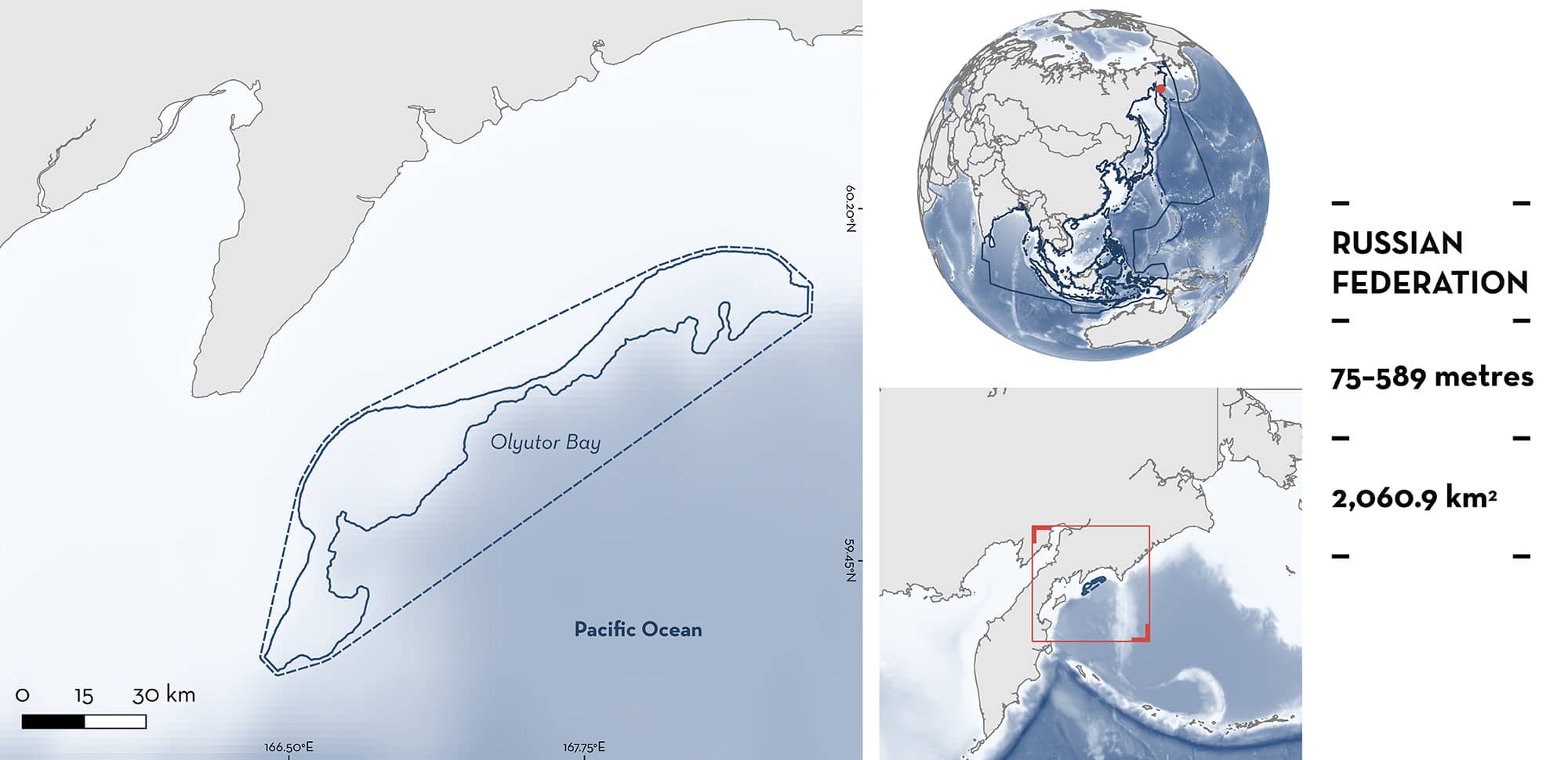ISRA FACTSHEETS
ISRA FACTSHEETS
ASIA REGION
Olyutor Bay
Summary
Olyutor Bay is located in the Bering Sea, in the waters of the Russian Federation. The area is characterised by a narrow slope and the presence of canyons with numerous rivers and streams flowing into the bay. Within the area there are: undefined aggregations (e.g., Aleutian Skate Bathyraja aleutica).
Download factsheet
Olyutor Bay
DESCRIPTION OF HABITAT
Olyutor Bay is located in the Bering Sea, on the northeast coast of Kamchatka in the Russian Federation, between the Olyutor and Goven peninsulas. It represents the ninth standard area for averaging biostatistical information during ongoing monitoring studies in the western Bering Sea (Shuntov et al. 2014). The bay has the shape of an arc turned to the south extending into the mainland for 83 km and reaches depths of 1,000 m in the southern part. It is characterised by a narrow continental shelf and the presence of canyons. Numerous rivers and streams flow into the bay. During December, fast ice appears in the bay that lasts until the end of April. In summer, sea surface temperatures rise to +10°C, but at >50 m depth they never exceed -1.7°C.
This Important Shark and Ray Area is benthopelagic and subsurface and is delineated from 75 m to 589 m based on the depth range of Qualifying Species in the area.
CRITERION C
SUB-CRITERION C5 – UNDEFINED AGGREGATIONS
Olyutor Bay is an important area for undefined aggregations of three ray species.
Skates are known to aggregate, with temporal changes in aggregations related to sex and life-stage segregations (Swain & Benoît 2006; Frisk 2010; Hoff 2010). Skate aggregations are usually related to high density areas where large catch quantities occur (Bizzarro et al. 2014). Scientific surveys using benthic trawls between 2010–2021 showed that aggregations of Aleutian Skate, Duskypurple Skate, and Whitebrow Skate regularly occur in Olyutor Bay (Orlov & Volvenko 2022; Orlov & Volvenko unpubl. data 2023). Catch-per-unit-effort (CPUE; individuals/km2) for each species was calculated based on the area swept by survey trawls (Volvenko 2014; Orlov & Volvenko 2022).
This area holds the largest abundance of Aleutian Skate (mean: 556 individuals/km2, max: 2,437 individuals/km2) in Russian waters of the Northwest Pacific (Grigorov et al. 2022; Orlov & Volvenko 2022). Individuals of this species were caught in other areas of the region but in minimal numbers compared to Olyutor Bay where it was exclusively found during the month of September at depths between 248–589 m, with multiple individuals caught in a single haul (Orlov & Volvenko 2022). More information is needed to confirm the nature of these aggregations.
This area holds the largest abundance of Duskypurple Skate (mean: 387 individuals/km2, max: 2,925 individuals/km2) in Russian waters of the Northwest Pacific (Orlov & Volvenko 2022; Orlov & Volvenko unpubl. data 2023). Compared to other sampled areas, the largest abundances were found in Olyutor Bay between May and December at depths between 194–589 m with multiple individuals caught in a single haul. More information is needed to confirm the nature of these aggregations.
This area holds the third largest abundance of Whitebrow Skate (mean: 125 individuals/km2, max: 471 individuals/km2) in Russian waters of the Northwest Pacific (Orlov & Volvenko 2022; Orlov & Volvenko unpubl. data 2023). Compared to other sampled areas, the largest abundances were found in Olyutor Bay year-round except for January, at depths between 75–589 m, with multiple individuals caught in a single haul. More information is needed to confirm the nature of these aggregations.
Download factsheet
SUBMIT A REQUEST
ISRA SPATIAL LAYER REQUEST
To make a request to download the ISRA Layer in either a GIS compatible Shapefile (.shp) or Google Earth compatible Keyhole Markup Language Zipped file (.kmz) please complete the following form. We will review your request and send the download details to you. We will endeavor to send you the requested files as soon as we can. However, please note that this is not an automated process, and before requests are responded to, they undergo internal review and authorization. As such, requests normally take 5–10 working days to process.
Should you have questions about the data or process, please do not hesitate to contact us.


